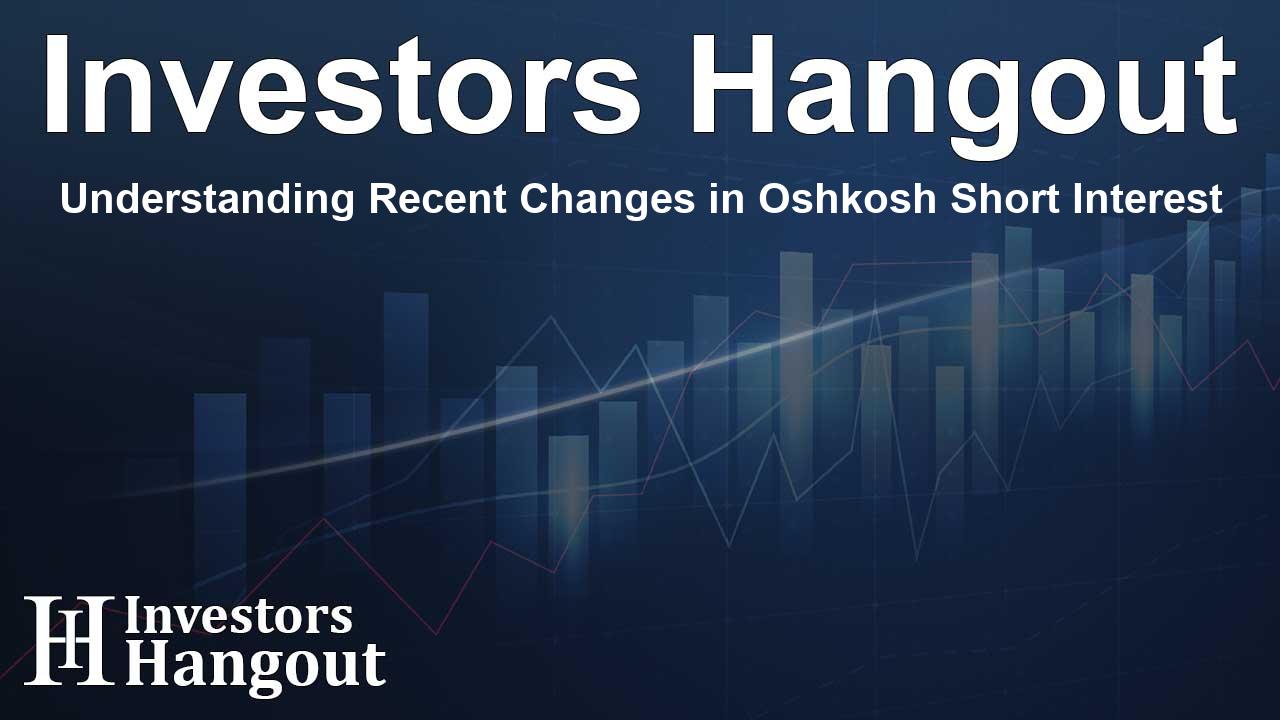Understanding Recent Changes in Oshkosh Short Interest

Understanding Oshkosh's Short Interest Dynamics
Oshkosh, a significant player in the automotive and defense sectors, has recently experienced a noteworthy shift in its short interest. The company's short percent of float has decreased by 15.23% since its last report. Currently, there are approximately 926 thousand shares sold short, representing 2.17% of the total accessible shares for trading. This decline suggests increased trader confidence, as it would take about 1.59 days for traders to cover their short positions based on the current trading volume.
Importance of Tracking Short Interest
Understanding short interest is crucial for investors and traders. It reflects the number of shares that investors have sold short but not yet bought back. Essentially, short selling occurs when traders sell shares they do not own, anticipating a decline in stock price. If the stock does fall, they can repurchase it at a lower price to return to the lender, thus making a profit. Conversely, if the stock rises, they face potential losses.
Market Sentiment Indicators
Short interest serves as a valuable indicator of market sentiment toward a specific stock. An uptick in short interest typically suggests that investors are taking a bearish stance, expecting the stock's price to decline further. Conversely, a decrease in short interest, like that observed with Oshkosh, often indicates a more bullish sentiment from traders, potentially reflecting a belief that the company's stock may rise.
Oshkosh's Recent Short Interest Trend
The recent trends in Oshkosh's short interest highlight a critical shift. The figures show a marked decline, signaling that fewer traders are betting against the stock. While this does not guarantee an immediate rise in stock price, it is essential information for investors to consider. Awareness of these shifts can influence trading strategies and investment decisions.
Peer Comparisons: Insights into Market Position
To further contextualize Oshkosh's short interest, it is helpful to compare it against its peers. Analysts frequently employ this comparison method to assess how well a company fares within its sector. For Oshkosh, the average short interest among its peers stands at 3.49%. This indicates that Oshkosh has comparatively lower short interest, suggesting a more optimistic outlook from the market.
Implications of Increasing Short Interest
Interestingly, rising short interest can sometimes signal a bullish outlook for a stock. This occurs when a stock that has been heavily shorted experiences a price increase, potentially leading to a short squeeze where short sellers are forced to buy back shares at higher prices. Thus, it can create upward momentum for the stock.
Conclusion: Staying Informed
In the dynamic world of stock trading, being informed about short interest trends is vital. For Oshkosh (NYSE: OSK), the recent decline in short interest reflects a shift in trader sentiment towards a more optimistic view. Investors should continue to monitor these indicators as they formulate their trading strategies.
Frequently Asked Questions
What is short interest?
Short interest is the total number of shares of a company that have been sold short but not yet covered. It serves as an indicator of investor sentiment.
Why is Oshkosh's short interest important?
The short interest of Oshkosh provides insights into market perceptions and trader behavior regarding the stock's future performance.
How does a decrease in short interest affect stock prices?
A decrease in short interest typically signals increased confidence in a company's stock, possibly leading to a price increase. However, it is not a certainty.
What does it mean when short interest is lower than peers?
Lower short interest compared to peers suggests that market sentiment is more favorable towards that company, indicating potential growth and stability.
Can increasing short interest be a positive sign?
Yes, rising short interest can indicate potential for a short squeeze, which may result in a price increase when shorts are forced to cover their positions.
About Investors Hangout
Investors Hangout is a leading online stock forum for financial discussion and learning, offering a wide range of free tools and resources. It draws in traders of all levels, who exchange market knowledge, investigate trading tactics, and keep an eye on industry developments in real time. Featuring financial articles, stock message boards, quotes, charts, company profiles, and live news updates. Through cooperative learning and a wealth of informational resources, it helps users from novices creating their first portfolios to experts honing their techniques. Join Investors Hangout today: https://investorshangout.com/
Disclaimer: The content of this article is solely for general informational purposes only; it does not represent legal, financial, or investment advice. Investors Hangout does not offer financial advice; the author is not a licensed financial advisor. Consult a qualified advisor before making any financial or investment decisions based on this article. The author's interpretation of publicly available data shapes the opinions presented here; as a result, they should not be taken as advice to purchase, sell, or hold any securities mentioned or any other investments. The author does not guarantee the accuracy, completeness, or timeliness of any material, providing it "as is." Information and market conditions may change; past performance is not indicative of future outcomes. If any of the material offered here is inaccurate, please contact us for corrections.